 |
PO
Box 9021, Wilmington, DE 19809, USA
E-mail: font@focusonnature.com
Phone: Toll-free in USA 1-888-721-3555
or 302/529-1876
|
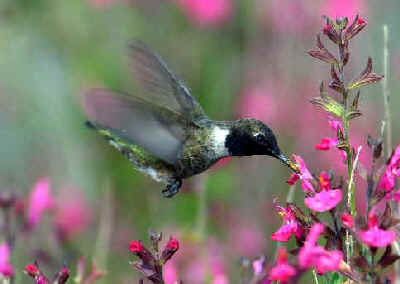 Birds
of TEXAS
Birds
of TEXAS
and some in
nearby NEW MEXICO
From Quails to Becard
Noting those during
Focus On Nature Tours
with an (*)
thru 2015
during the months of
January, March,
April, May, and December
PHOTO AT UPPER RIGHT: a
male BLACK-CHINNED HUMMINGBIRD
(photo by
Howard Eskin)
Part 1 of a List of Texas Birds compiled by Armas Hill,
with some photos
IN TEXAS, MORE SPECIES OF BIRDS HAVE BEEN FOUND THAN IN ANY OTHER U.S. STATE.
As many as 402 species of birds have cumulatively been seen during FONT tours in Texas and nearby New Mexico.
Link:
Part 2 of this List of Texas Birds, Flycatchers to Buntings
Codes:
c: central -
including areas of San Antonio & Austin, the Edwards Plateau (or "Hill Country")
& Fort Clark Springs
e: east -
along the Gulf Coast, including the areas of Rockport & Aransas
n: north
- including the Texan
Panhandle
s: south - the southern Rio Grande Valley, as far upriver as
Laredo, and north to the King Ranch, the Welder Wildlife Refuge, and Choke
Canyon
w: west - including Big Bend National Park, the Davis
Mountains area,
& lakes near I-10
nm:
in nearby New Mexico
mx:
seen across the Rio Grande in Mexico
(mex):
a mostly
"Mexican species" that occurs in Texas
(some of these birds are also common further south in the tropics)
(win)
- occurs mostly in the winter
(thru)
- occurs throughout the state
(USe):
endemic
to the United States
(USqe): quasi (or nearly) endemic to the
United States
(USeb): endemic-breeder in the United
States
(USneb): near-endemic breeder in the United States
(NAi): species introduced into North America
(USri): re-introduced species
into the United States
(USr): rare in the
United States
(TXr): rare in Texas
(NMr): rare in New Mexico
(t): a globally threatened or rare species, designated by Birdlife International
(t1): critical (t2): endangered (t3): vulnerable
(nt): a near-threatened species globally
(ph); species with a photograph in the FONT website
Birds seen during FONT tours in Texas and/or New Mexico
in:
March: mar April: apr May:
may
Links to Bird Groupings in this
List:
Gallinaceous Birds
Waterfowl Loons
Pelagic Birds
Grebes Ibises & Spoonbill
Storks & Flamingo Bitterns, Herons,
Egrets Tropicbird, Frigatebird, Pelicans, Boobies, Gannet
Cormorants & Anhinga
Raptors (inc. Vultures) Rails &
allies Cranes Shorebirds
Jaegers, Gulls, Terns, Skimmer
Pigeons &
Doves Parakeets & Parrots
Cuckoos &
Allies Owls
Nighthawk & Nightjar
Swifts Hummingbirds
Trogon & Kingfishers
Woodpeckers
Other Links:
Upcoming
FONT Birding & Nature Tours in North America, including Texas
A
Complete List & a Photo Gallery of North American Birds, north of Mexico, in
6 parts:
Part #1: Grouse to Anhinga
Part #2: Condor to
Shorebirds Part #3: Jaegers to Cuckoos
Part #4: Owls to
Flycatchers Part #5 Shrikes to Pipits
Part #6: Olive Warbler to
Buntings
Lists of Other Texas Wildlife (each with some
photos):
Mammals
Butterflies
Dragonflies &
Damselflies Amphibians & Reptiles
Marine Life (inc.
Fish, Jellyfish, Mollusks (Shells), & Arthropods: Crustaceans &
Echinoderms)
Plants
of the Desert & Some Nearby Habitats (with some photos)
Notes regarding some Texas Plant-Life
Directory of Photos in this Website

Bird-List:
GALLINACEOUS
BIRDS
- Scaled Quail (*) ______ c,w
nm apr may
Callipepla squamata pallida
The populations of the Scaled Quail, in much of its range,
has declined rather dramatically in recent years.
The reasons are not known for sure, but are probably due to changes in
land-use practices and the loss of preferred
habitat.
- Gambel's Quail (ph) (*) ______ w
apr may
Callipepla g. gambelii
- Northern Bobwhite (nt) (*) ______ e,s
mar apr may
Colinus virginianus
- Montezuma Quail (*) ______ w
apr
Cyrtonyx montezumae mearnsi
Cyrtonyx montezumae
has historically been called the Harlequin Quail. The subspecies
in Texas has been called the "Mearn's Quail".
The plumage of the male Montezuma Quail is certainly one
of the most strikingly patterned of Texas birds.
The legs and feet of the species are strong and so well adapted to scratch
and dig in the hard, rocky ground that is characteristic in the bird's
preferred habitat.
- Plain Chachalaca (ph) (*) ______ s
(mex) may
Ortalis vetula
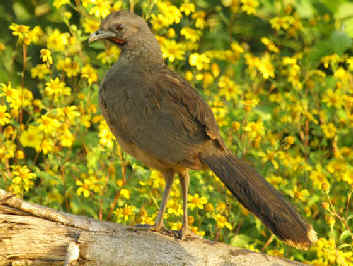
Plain Chachalaca
(photo by Dick Tipton)
- "Attwater's" Greater Prairie
Chicken (t1) (*) ______ e
Tympanuchus cupido attwateri
As of 2003, the population of the race of the Greater Prairie Chicken
in the Coastal Prairies region of Texas, known as the "Attwater's
Prairie Chicken", fell to less than 70 birds.
Conservation initiatives have been underway, for hopefully the number to
increase by the releasing of captive-raised birds into the
wild.
- Lesser Prairie Chicken (t3) (USe) (ph)
______ n
Tympanuchus
pallidicinctus
The Lesser Prairie Population
population in Texas (and elsewhere) is declining, and the species seems to
be imperiled.
It is well known that the males display in the spring at leks on their
breeding grounds, but not as well known is that they also do, to a lesser
extent, in October and November, due to a slightly elevated testosterone
level that occurs in the fall.
- Wild Turkey (ph) (*) ______ e,c,w
nm mar apr may
Meleagris galloparo
- Common Pheasant (NAi) (*) ______ nm
Phasianus colchicus
WATERFOWL
- Black-bellied Whistling Duck (ph)
(*) ______ e,s,c (mex) apr
may
Dendrocygna autumnalis
As recently as the 1960s, Black-bellied Whistling Ducks
were found in Texas only in the Lower Rio Grande Valley and north in Coastal
prairies almost to Corpus Christi. The species is now found throughout much
of the southern part of the state, and locally as far north as the
Dallas-Fort Worth area.
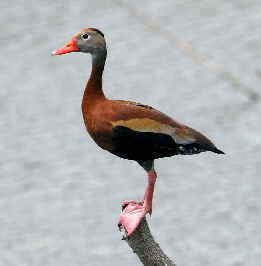
Black-bellied Whistling Duck
(photo by Howard Eskin)
- Fulvous Whistling Duck ______
Dendrocygna bicolor
- Greater White-fronted Goose (*)
______ e
Anser albifrons
- Snow Goose (ph) (*) _______ e
Chen
(has been Anser) caerulescens
- Ross's Goose ______
Chen
(has been Anser) rossi
- Canada Goose (*) ______ e
Branta canadensis
- Cackling Goose (ph) (*) ______ e
Branta hutchunsii
- Trumpeter Swan (nt) (ph) ______
Cygnus buccinator
The Trumpeter Swan was once a
regular visitor to the eastern two-thirds of Texas until the late 1800s.
Now, due to the reintroduction programs in the Midwest, the species has been
reappearing in Texas.
- Tundra Swan ______
Cygnus columbianus
- Muscovy Duck (ph) (*) ______ s (mex)
Cairina moschata
The Muscovy Duck is widespread throughout the Neotropics. Prior
to 1984, it was not found in Texas. A small population has since become
established along the Rio Grande River in Starr and Zapata Counties.
- Wood Duck (ph) (*) ______ w
apr may
Aix sponsa
- Gadwall (ph) (*) ______ e,w
mar apr
Anas strepera
- American Wigeon (ph) (*) ______
e,c,w
mx mar apr
Anas americana
- Eurasian Wigeon (ph) ______
Anas penelope
The Eurasian Wigeon has
occurred in Texas most frequently in the western part of the state. Most of
the individuals found in Texas have been alternate-plumaged males.
- American Black Duck (TXr) (ph)
______
Anas rubripes
- Mallard (ph) (*) ______
c mar may
Anas platyrhynchos
- Mexican Duck (*) ______ w
mx apr may
Anas platyrhynchos diazi
The Mexican Duck has been considered conspecific with
the Mallard.
- Mottled Duck (*) ______ e,s
mx mar apr may
Anas fulvigula
The Mottled Duck is a common resident in Texas along the
Coastal Prairies and locally inland to the north-central and northeast
portions of the state.
- Blue-winged Teal (ph) (*) ______ e,s,w
nm mar apr may
Anas discolors
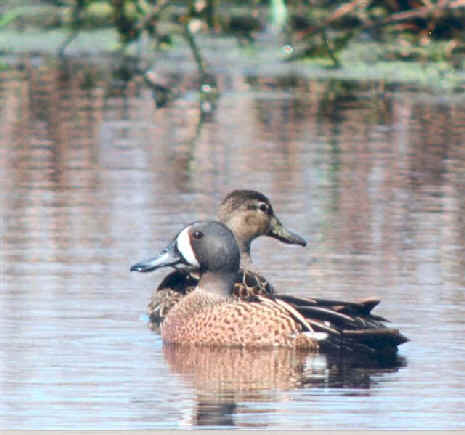
Blue-winged Teal
(photo by Marie Gardner)
- Cinnamon Teal (*) ______ s
Anas cyanoptera
- Northern Shoveler (ph) (*) ______ e,s,w
nm,mx mar apr may
Anas clypeata
- Northern Pintail (ph) (*) ______
e,w mar apr
may
Anas acita
- White-cheeked Pintail (USr) (TXr)
______
Anas bahamensis
- Garganey (USr) (TXr) ______
Anas querquedula
The Garganey has occurred
in Texas just a few times (4). The records have been alternate-plumaged
males found during spring migration.
- Green-winged Teal (ph) (*) ______
e,c,w mar
may
Anas carolinensis
The Green-winged Teal of North America has been considered
conspecific with the Eurasian Teal, Anas crecca.
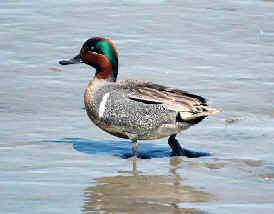
A male Green-winged Teal
(photo by Howard Eskin)
- Lesser Scaup (ph) (*) ______
c mar
Aythya affinis
- Greater Scaup ______
Aythya marila
- Ring-necked Duck (ph) (*) ______ nm
Aythya collaris (monotypic)
- Canvasback (*) ______
Aythya valisineria
- Redhead (ph) (*) ______ e,c,w
mar apr
Aythya americana
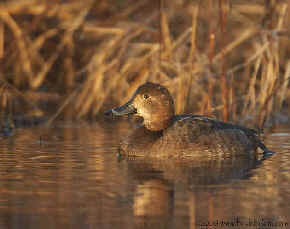
A female Redhead
(photo by Kim Steininger)
- King Eider (TXr) (ph) ______
Somateria spectabilis
A subadult male King Eider, in worn plumage, was in Texas in
Brazoria County, at Quintana, from April 30 to May 7, 1998. It was captured
for rehabilitation.
- Harlequin Duck (TXr) (ph)
______
Histrionicus histrionicus
- Surf Scoter (ph) ______
Melanitta perspicillata
- White-winged Scoter (*) ______
e mar
Melanitta fusca
- Black Scoter (ph) ______
Melanitta americana
The Black Scoter of North America & eastern Asia has been
considered conspecific with the Common Scoter of Europe, Melanitta
niger.
- Long-tailed Duck (t3) (ph) ______
Clangula hyemalis
- Bufflehead (ph) (*) ______ e,w
mar apr
Bucephala albeola
- Common Goldeneye (*) ______
Bucephala clangula
- Barrow's Goldeneye (TXr) ______
Bucephala islandica
- Hooded Merganser (ph) (*) ______
s mar
Lophodytes cucullatus
- Red-breasted Merganser (ph) (*) ______
Mergus serrator
- Common Merganser (ph) ______
Mergus merganser
- Masked Duck (USr) (TXr) ______
Nomonyx dominicus
Coincidence or not, the occurrence of the Masked Duck in Texas
over the years has been highly cyclical.
For whatever reason, if for a reason at all, there have been
"invasions" about every 20 to 30 years since the 1890s, with only
a few scattered records during the intervening periods. The most recent
invasion was from 1992 to 1996.
- Ruddy Duck (ph) (*) ______ e,w
mar apr may
Oxyura j. jamaicensis
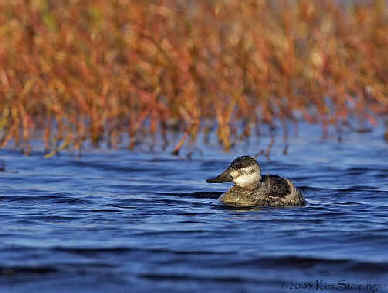
A female Ruddy Duck
(photo by Kim Steininger)
LOONS
- Common Loon (*) ______
Gavia immer
- Red-throated Loon (ph)
______
Gavia stellata
- Pacific Loon (ph)
______
Gavia pacifica
- Yellow-billed Loon
(TXr) ______
Gavia adamsii
There have only been a few
records in Texas (5) of the Yellow-billed Loon. Two of them were at
Balmorhea Lake in Reeves County in the western part of the state.
.
PELAGIC BIRDS
- Atlantic Yellow-nosed
Albatross (t2) (USr) (TXr) ______
Thalassache chlororhynchos
- Black-capped
Petrel (t2) (TXr) (ph) ______
Pterodroma hasitata
The Black-capped Petrel is
common in the Gulf Stream off the southeast United States. It is rare in the
Gulf of Mexico.
A bird in July 1997 off Port O'Connor, in Calhoun County, was the second
documented record in Texas waters.
- Stejneger's Petrel
(t3) (USr) (TXr) ______
Pterodroma longirostris
- White-chinned
Petrel (t3) (USr) (TXr) ______
Procellaria longirostris
The White-chinned Petrel
is a bird of the oceans of the Southern Hemisphere. An individual that was
found on the beach in Galveston County, Texas, on February 27, 1986, was the
first record for the species in North America.
- Cory's Shearwater
(ph) ______
Calonectris diomedea
- Great Shearwater (TXr)
(ph) ______
Puffinus gravis
- Sooty Shearwater (TXr)
(ph) ______
Puffinus griseus
- Manx Shearwater (TXr)
______
Puffinus puffinus
- Audubon's
Shearwater (ph) ______
Puffinus iherminieri
- Wilson's Storm
Petrel (TXr) (ph) ______
Oceanites oceanicus
- Leach's Storm
Petrel (TXr) ______
Oceanodroma leucprhoa
- Band-rumped Storm
Petrel ______ (has also been called Madeiran or
Harcourt's Storm Petrel)
Oceanodroma castro
GREBES
- Least Grebe (ph) (*) ______ e,s
mar may
Tachybaptus dominicus
The Least Grebe is widespread throughout the Neotropics.
The northern extent of its range is in Texas, where it prefers small ponds
with abundant emergent vegetation.
- Pied-billed Grebe (*) ______ e,s,c,w
mar apr may
Podilymbis p. podiceps
- Eared Grebe (ph) (*) ______ w
apr may
Podiceps nigricollis californicus
Another name for Podiceps
nigricollis is the Black-necked Grebe. It is so called
in the Old World.
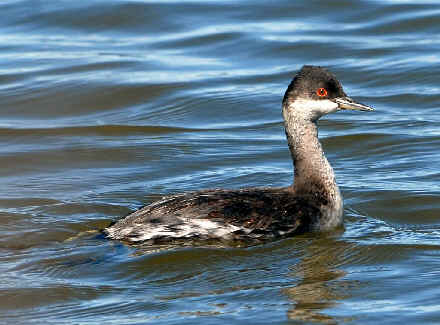
The Eared, also known as the Black-necked,
Grebe
(photo by Howard Eskin)
- Red-necked Grebe (ph) (TXr) ______
Podiceps grisegena
- Western Grebe (ph) (*) ______ w
apr may
Aechmophorus occidentalis
The Western Grebe and the Clark's Grebe (below)
were conspecific.
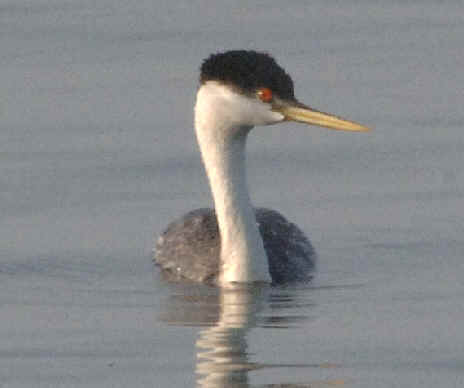
Western Grebe
- Clark's Grebe (*) ______ w
apr may
Aechmophorus clarkii
IBISES & SPOONBILLS
- American White Ibis (ph) (*) ______ e
mar apr may
Eudocimus albus
- White-faced Ibis (ph) (*) ______
e,s,w
nm mar apr may
Plegadis chihi
- Glossy Ibis (ph) (*) ______
e may
Plegadis falcinellus
- Roseate Spoonbill (ph) (*) ______ e,s
mar apr may
Ajaia ajaja
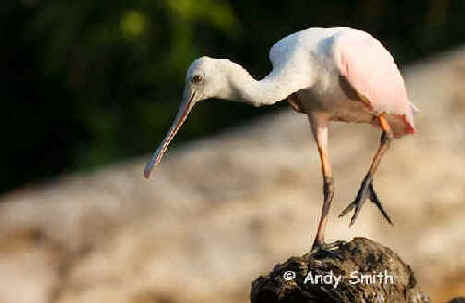
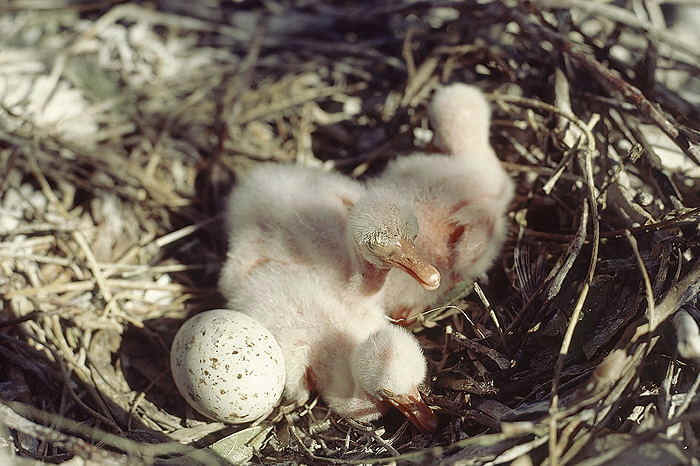
Two photographs of Roseate Spoonbills,
an adult
(above), and a chick on the nest (below)
STORKS & FLAMINGO
- Wood Stork (ph) ______
Mycteria americana
Wood Storks
occur in Texas as postbreeding wanderers from breeding populations in
Florida and Mexico. The highest numbers in Texas are between late June and
early November.
- Jabiru (USr) (TXr) (ph) ______
Jabiru mycteria
The Jabiru has occurred in Texas on only a few occasions. It
normally occurs in southern Mexico (rarely) and further south in Central
& South America.
The vagrants in Texas have been postbreeding wanderers that reached the
state between late July and late October.
- American Flamingo (USr) (TXr) (ph)
______
Phoenicopterus ruber
BITTERNS, HERONS, EGRETS
- American Bittern (ph) (*) ______ e
Botaurus lentiginosus
- Least Bittern (ph) (*) ______ e
apr
Ixobrychus exilis
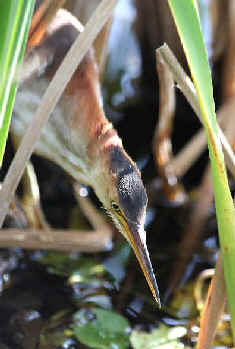
Least Bittern
(photo by Doris Potter)
- Great Blue Heron (*) ______ e,s,c,w
mar apr may
Ardea herodias
- Great Egret (ph) (*) ______ e,s,c,w
mx mar apr may
Casmerodius
(has been Ardea) alba egretta
- Snowy Egret (ph) (*) ______ e,s,w mx
mar apr may
Egretta thula brewsteri
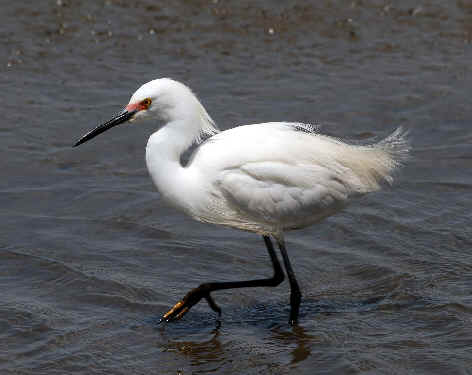
A Snowy Egret in breeding plumage, with red lores
(photo by Howard Eskin)
- Little Blue Heron (ph) (*) ______ e
mar apr may
Egretta caerulea
- Tricolored Heron (ph) (*) ______ e,s
mar apr may
Egretta tricolor
A former common name for Egretta tricolor
was the Louisiana Heron.
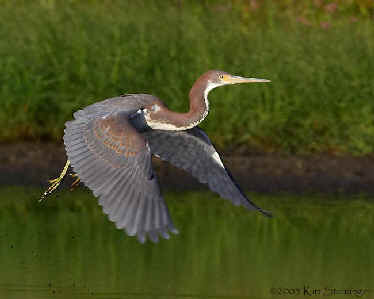
Tricolored Heron
(photo by Kim Steininger)
- Reddish Egret (ph) (*) ______ e
apr may
Egretta rufescens
There are two morphs of the Reddish Egret: white and dark.
- Western Cattle Egret (ph) (*) ______ e,s,w
mx apr may
Bubulcus ibis
The Eastern Cattle Egret, Bubulcus
coromandus, occurs in southern & eastern
Asia.
- Green Heron (*) ______ e,s,w
nm mar apr may
Butorides virescens anthonyi
- Black-crowned Night Heron (*) ______ e,s,w
nm mar apr may
Nycticorax nycticorax hoactii
- Yellow-crowned Night Heron (ph) (*) ______ s
may
Nyctanassa violacea
TROPICBIRD,
FRIGATEBIRD, PELICANS, BOOBIES &
GANNET
- Red-billed
Tropicbird (ph) ______
Phaethon aethereus
- Magnificent Frigatebird (ph)
______
Fregata magnificens
The only breeding population of
the Magnificent Frigatebird in the United States is in Florida.
The bird is an uncommon postbreeding wanderer to Texas. A few non-breeding
birds can be found as early as April along the Gulf Coast, but most arrive
in the late summer and early fall.
- American White Pelican (ph) (*) ______
e,s,w mar
apr may
Pelecanus erythrorhynchos
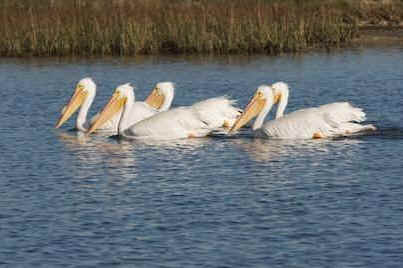
American White Pelicans along the Texas Gulf
Coast
(photo by Marc Felber)
- Brown Pelican (ph) (*) ______ e,s,w
(rare in west TX) mar
apr may
Pelecanus occidentalis carolinensis
The Brown Pelican population in Texas dipped so low that there
were less than 20 individuals in the state in 1970s. It rebounded,
thankfully, due to conservation efforts and the banning of the pesticide
DDT.
- Masked Booby (USr) (TXr) ______
Sula dactylatra
- Blue-footed Booby (USr) (TXr)
(ph) ______
Sula nebouxii
There was a famous occurrence of a Blue-footed Booby in Texas at
Lake Lyndon B. Johnson in Burner/Llano Counties in 1993/94. The bird stayed
there for more than a year, during which time it molted into adult plumage.
It has been the only occurrence of the species in Texas.
The Blue-footed Booby is normally to the west of Texas in the area of
the Gulf of California, and elsewhere in the Pacific from Mexico south to
Ecuador.
- Brown Booby (TXr) (ph) ______
Sula leucogaster
- Red-footed Booby (USr) (TXr)
______
Sula sula
- Northern Gannet (ph) ______
Morus bassanus
CORMORANTS & ANHINGA
- Neotropic Cormorant (ph) (*) ______ e,s,c,w
(mex) mar apr may
Phalacrocorax brasilianus mexicanus
- Double-crested Cormorant (*) ______ e,s,w
mar apr may
Phalacocorax a. auritus
- Anhinga (ph) (*) ______ e
apr
Anhinga anhinga leucogaster
RAPTORS (including VULTURES)
- Black Vulture (ph) (*) ______ e,s,c,w
mx mar apr may
Coragyps atratus
- Turkey Vulture (ph) (*) ______ e,s,c,w
nm,mx mar apr may
Cathartes aura
- Northern Crested Caracara (ph) (*) ______ s,c
(mex) mar may
Caracara cheriwayi
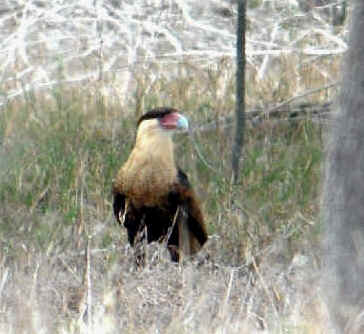
Northern Crested
Caracara
(photo by Howard Eskin)
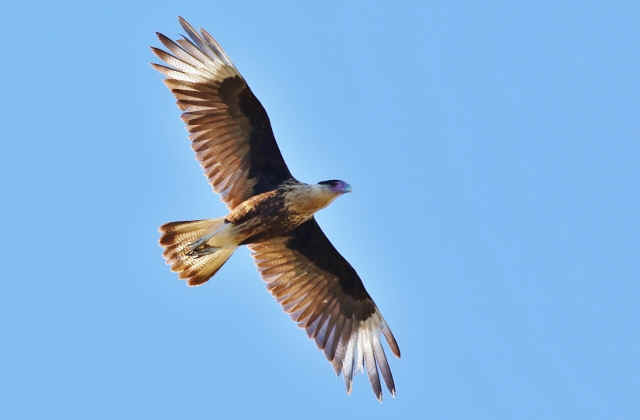
- American Kestrel (ph) (*) ______
e,c,w mar apr
may
Falco s. sparverius
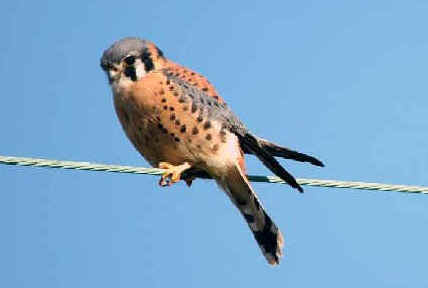
American Kestrel
(photo by Howard Eskin)
- Merlin (ph) (*) ______ e,c
mar apr
Falco c. columbarius
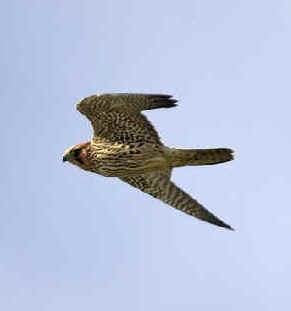
A Merlin in flight
- Aplomado Falcon (NAri) (NAr) (ph) (*) ______ s,e
(mex) mar may
Falco femoralis
Prior to about 1920, the Aplomado Falcon was a summer
resident across the brush country of the Trans-Pecos and South Texas.
A reintroduction project, that began in 1989, has returned this falcon of
the grasslands to some of its former haunts. Birds released at the Laguna
Atascosa National Wildlife Refuge, in Cameron County, were part of the
program.
- Peregrine Falcon (ph) (*) ______ e
apr
Falco peregrinus
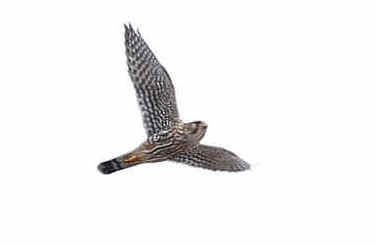
A Peregrine Falcon in flight, photographed in Texas
(photo by Rhett Poppe)
- Prairie Falcon (ph) (*) ______ w
Falco mexicanus
- Gyrfalcon (TXr) ______
Falco rusticollis
A Gyrfalcon, that
faithfully roosted on a water tower in Lubbock from January 22 to April 7,
2002, was the first to be documented in Texas. That record is apparently the
southernmost in North America.
- Collared Forest
Falcon (USr) (TXr) ______
Micrastur semitorquatus
- Osprey (ph) (*) ______ e,s,w
mar apr may
Pandion haliaetus carolinensis
- Hook-billed Kite (TXr) (*) ______ s
Chondrohierax uncinatus
The northern edge of the range of the Hook-billed Kite just
reaches Texas in the Lower Rio Grande Valley.
This raptor feeds primarily on land snails, using the extended hook on the
tip of their bill to extract the snail from its shell.
- Swallow-tailed
Kite (ph) ______
Elanoides forticatus
The Swallow-tailed Kite
was a common nesting species in eastern Texas until the early 1900s. By
1915, that breeding population had all but disappeared, but during recent
decades the species has been found with increasing frequency during the
summer in the southeastern quadrant of the state and as migrants
elsewhere,
- White-tailed Kite (ph) (*) ______ s
may
Elanus leucurus
- Mississippi Kite (*) ______ s
may
Ictinia mississippiensis
- Snail Kite (TXr)
(ph) ______
Rostrhamus sociabilis
- Bald Eagle (ph) (*) ______ e
may
Haliaeetus leucocephalus
- Northern Harrier (ph) (*) ______
e,s,c,w mar
apr may
Circus hudsonius
The Northern Harrier has been considered conspecific with the Hen
Harrier of Eurasia, Circus cyaneus.
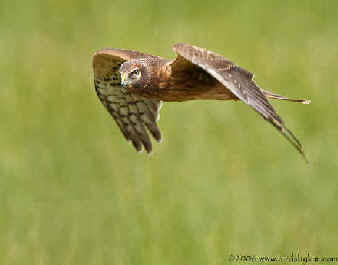
A female Northern Harrier
(photo by Kim Steininger)
- Sharp-shinned Hawk (ph) (*) ______
Accipiter striatus
- Cooper's Hawk (ph) (*) ______ e,c,w
mar apr may
Accipiter cooperi
-
Northern Goshawk (TXr) ______
Accipiter gentilis
- Crane Hawk (USr) (TXr)
(ph) ______
Geranospiza caerulescens
There has only been one record of
the Crane Hawk in the United States. It was an adult that spent
almost 4 months at the Santa Ana National Wildlife Refuge in Hidalgo County,
during the winter of 1987-88.
- Gray Hawk (ph) (*) ______ w
may
Buteo plagiatus
The Gray Hawk was merged with the Gray-lined Hawk, Buteo
nitida, of southern Central America and South America.
- Common Black Hawk (ph) (*) ______
w apr
Buteogallus a. anthracinus
- Harris's Hawk (ph) (*) ______ s,c,w
apr may
Parabuteo unicinctus harrisi
Another common name for Parabuteo
unicinctus is the Bay-winged Hawk.
- Broad-winged Hawk (NMr) (*) ______ nm
Buteo p. platypterus
- Red-shouldered Hawk (*) ______ s,c
mar may
Buteo lineatus
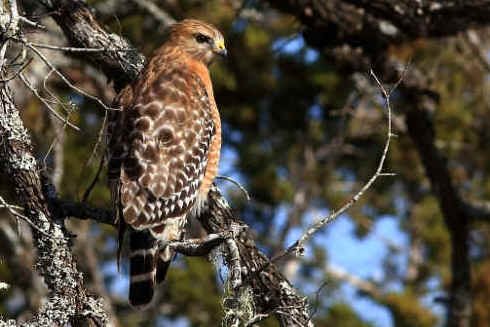
A Red-shouldered Hawk photographed in Wimberley, Texas
(photo by Rhett Poppe)
- Swainson's Hawk (ph) (*) ______
e,s,c,w nm apr may
Buteo swainsoni
(monotypic, but with light & dark morphs)
- White-tailed Hawk (*) ______ e,s
mar apr may
Buteo albicaudatus
The White-tailed Hawk is widespread throughout the
American tropics. Within the United States, it is only found in Texas.
The species is well known for preying on small animals fleeing grassland
fires, and it responds to smoke indicating the presence of a fire from more
than 10 miles away.
- Zone-tailed Hawk (ph) (*) ______ w
Buteo albonotatus
- Red-tailed Hawk (ph) (*) ______ e,s,c,w
nm mar apr may
Buteo jamaicensis calurus
- Short-tailed Hawk
(TXr) (ph) ______
Buteo brachyurus
- Ferruginous Hawk (nt)
(ph) ______
Buteo regalis
- Rough-legged Hawk
(ph) ______
Buteo lagopus
-
Roadside Hawk (USr) (TXr) (ph) ______
Buteo magnirostris
- Golden Eagle (*) ______ w
nm apr
Aquila chrysaetos canadensis
RAILS & ALLIES
- Yellow Rail ______
Coturnicops noveboracensis
- Black Rail (*) ______ e
may
Laterallus jamaicensis
- Clapper Rail (ph) (*) ______ e
apr may
Rallus crepitans (was R. longirostris)
- King Rail (*) ______ s
may
Rallus elegans
- Virginia Rail
(ph) ______
Rallus limicola
- Sora (*) ______ e,w
mar apr may
Porzana carolina
- Paint-billed Crake
(USr) (TXr) ______
Neocrex erythrops
- Spotted Rail (USr)
(TXr) ______
Pardirallus maculatus
- Purple Gallinule (ph) (*) ______
e,s mar
may
Porphyrio martinicus
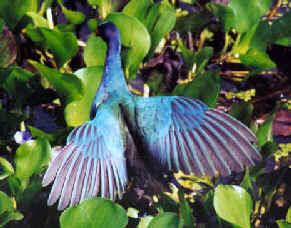
A Purple Gallinule photographed during a FONT tour
(photo by Marie Gardner)
- Common Gallinule (ph)
(*) ______ e,s mar
apr may
Gallinula galeata
- American Coot (*) ______ e,s,w
nm mar apr may
Fulica a. americana
CRANES
- Sandhill Crane (ph) (*) ______ e
mar
Grus canadensis
- Whooping Crane (t2) (*) ______ e
mar
Grus americana
Whooping Cranes
were once widespread along the Texas Gulf Coast. Now, the entire
natural population winters in a small section of the central Texas coast, in
and near the Aransas National Wildlife Refuge.
It has been that way for decades, but now the number of birds is greater
that it was in the mid-20th Century. During the winter of 1941-42, after a
century of shooting, egg-collecting, and habitat destruction (including the
drainage of Gulf Coast marshes to create rice fields) there were only 15
Whooping Cranes spending the winter at Aransas. At that time, that was
the entire population of the species in the
wild.
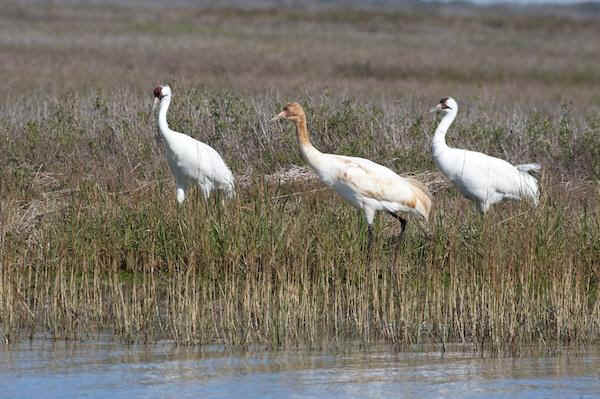
A family of Whooping Cranes at the Aransas
Refuge along the Texas Gulf Coast,
with the young bird flanked by its two parents (photo by Marc
Felber)
SHOREBIRDS
- Double-striped
Thick-knee (USr) (TXr) (ph) ______
Burhinus bistriatus
- Black-bellied (or Grey) Plover
(ph)
(*) ______ e,s apr
may
Pluvialis squatarola cynosurae
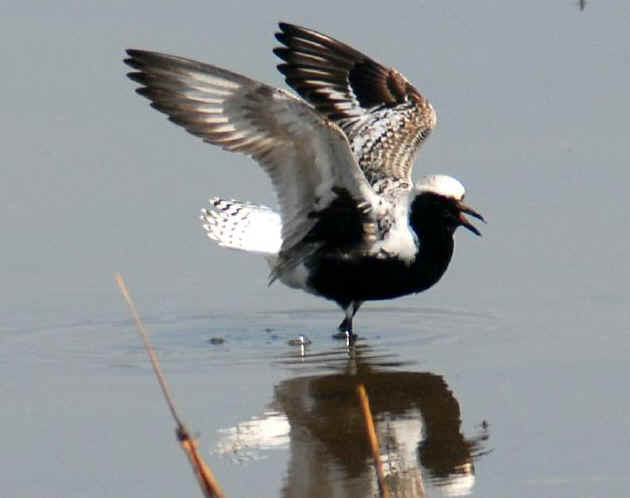
Black-bellied Plover
(photo by Howard Eskin)
- American Golden Plover (ph) (*)
______ e mar
Pluvialis dominica
- Snowy Plover (ph) (*) ______ w
apr
Charadrius nivosus
The Snowy Plover was conspecific with the Kentish
Plover of Eurasia, Charadrius alexandrinus.
- Wilson's Plover (ph) (*) ______ e,s
apr may
Charadrius wilsonia
Although the Wilson's Plover is often thought of as a
strictly coastal breeder in Texas, it has also been found nesting well
inland. It has been documented as breeding on saline ponds as far inland as
eastern Brooks County in south Texas.
- Semipalmated Plover (ph) (*) ______ e,s,w
apr may
Charadrius semipalmatus
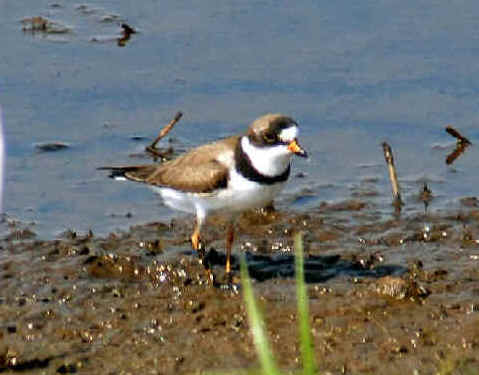
Semipalmated Plover
(photo by Howard Eskin)
- Piping Plover (t3) (ph) (*) ______ s
may
Charadrius melodus
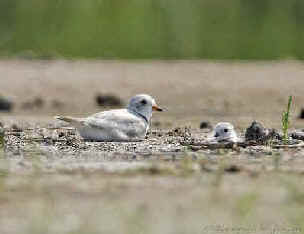
Piping Plover
(photo by Kim Steininger)
- Killdeer (ph) (*) ______ e,s,c,w
nm,mx mar apr may
Charadrius v. vociferus
- Mountain Plover (t3) (USneb) (ph)
______
Charadrius montanus
The Mountain Plover
population has seriously declined across the species' range. It is now
classified as "vulnerable" by Birdlife International. Unlike other
species in the Charadrius genus,
it is a grassland species, virtually never in
wetlands.
- Collared Plover (USr)
(TXr) ______
Charadrius collaris
The first Collared Plover in
the United States was found in Uvalde, Texas, about 90 miles west of San
Antonio. It was at a fish hatchery there in May 1992.
The 2nd Collared Plover in the US was also found in Texas, near
Hargill, on August 2, 2014.
The range of the species is throughout Central and South America.
- American Oystercatcher (ph) (*) ______ s
may
Haematopus palliatus
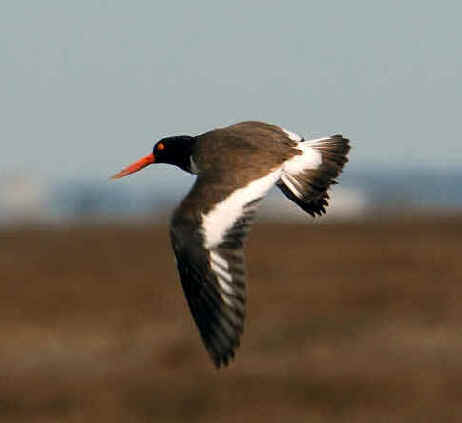
American Oystercatcher
(photo by Howard Eskin)
- Black-necked Stilt (ph) (*) ______ e,s,w
mar apr may
Himantopus mexicanus
The Black-necked Stilt has been considered by some to be
conspecific with the nearly-cosmopolitan Black-winged Stilt, Himantopus
himantopus.
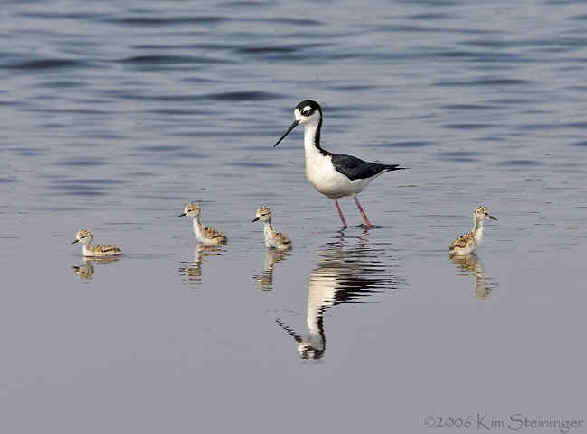
Black-necked Stilt
(photo by Kim Steininger)
- American Avocet (ph) (*) ______ e,s,w
apr may
Recurvirostra americana
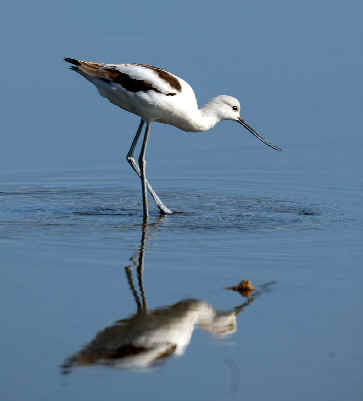
American Avocet
(photo by Howard Eskin)
- Northern Jacana (ph) (*) ______ s
Jacana spinosa
Ornithological literature from the late 1800s suggest that the Northern
Jacana was a rare resident in Texas in the Lower Rio Grande
Valley.
During the 1970s, there was a small population in Brazoria County, at Maner
Lake. Since then, the species has been a very rare visitor in
Texas.
- Greater Yellowlegs (ph) (*) ______
e,s,w mar apr may
Tringa melanoleuca
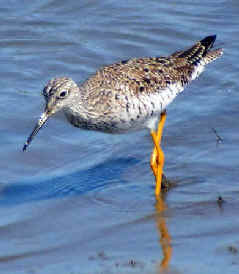
Greater Yellowlegs
(photo by Howard Eskin)
- Lesser Yellowlegs (ph) (*) ______ e,s,w
mar apr may
Tringa flavipes
- Solitary Sandpiper (*) ______ e,s
mar may
Tringa solitaria cinnamomea
- Willet (ph) (*) ______ e,s,w
mar apr may
Tringa
(formerly Catoptrophorus) s. semipalmatus
- Spotted Redshank (USr)
(TXr) ______
Tringa erythropus
- Wandering Tattler
(TXr) ______
Heteroscelus incanus
The Wandering Tattler has
been known to occur in Texas once. In the spring of 1992, there was one in Galveston.
- Spotted Sandpiper (ph) (*) ______ e,s,w
nm mar apr may
Actitis macularia
- Upland Sandpiper (*) ______
Bartramia longicauda
- Whimbrel (*) ______ e
mar may
Numenius phaeopus hudsonicus
- Long-billed Curlew (nt) (ph) (*) ______ w
apr may
Numenius americanus parvus
-
Eskimo Curlew ______ (now assumed to be extinct)
Numenius borealis
The last documented record of the Eskimo
Curlew in Texas was in 1962, in the Galveston area. There were about 20
accepted records in that area from 1959 to 1962.
Eskimo Curlews were formerly regular migrants in Texas in the spring,
with records occurring from March 8 to April 23.
- Marbled Godwit (ph) (*) ______ e
apr
Limosa fedoa
- Hudsonian Godwit (ph) (*) ______ s
Limosa haemastica
The Hudsonian Godwit has an elliptical migration route that
brings it through Texas during its journey northward, and along the Atlantic
seaboard (or even offshore) in the fall.
As a result, late summer and fall records of the species in Texas are very
rare.
- Surfbird (TXr)
______
Aphriza virgata
- Ruddy Turnstone (ph) (*) ______ e,s
mar apr may
Arenaria interpres morinella
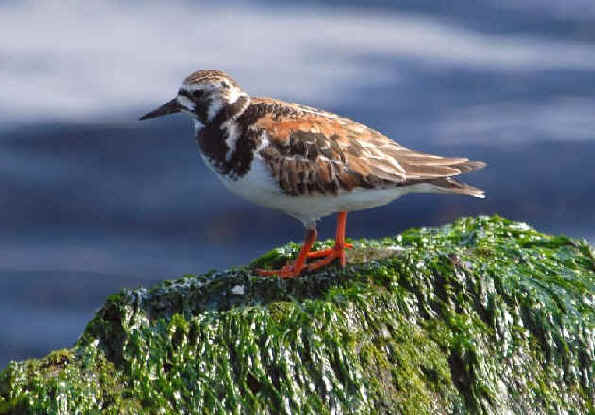
Ruddy Turnstone
(photo by Howard Eskin)
- Red Knot (ph) (*) ______ s
may
Calidris canutus rufa
- Sanderling (ph) (*) ______ e,s
mar apr may
Calidris alba rubida
- Semipalmated Sandpiper (*) ______ e,c
mar may
Calidris pusilla
- Western Sandpiper (ph) (*) ______ e,w
apr may
Calidris mauri
- Least Sandpiper (ph) (*) ______ e,c,w
mar apr may
Calidris minutilla
- White-rumped Sandpiper (ph) (*) ______ c
may
Calidris fuscicollis
- Baird's Sandpiper (ph) (*) ______ s,w
apr may
Calidris bairdii
- Pectoral Sandpiper (ph) (*) ______ e
may
Calidris melanotos
- Purple Sandpiper (ph) (*) ______ e
Calidris maritima
- Dunlin (ph) (*) ______ e,s
apr may
Calidris alpina
- Stilt Sandpiper (ph) (*) _______ e,s,w
apr may
Calidris
(was Micropalama) himantopus
- Red-necked Stint (USr) (TXr) (ph) ______
Calidris ruficollis
- Sharp-tailed
Sandpiper (USr) (TXr) (ph) ______
Calidris acuminata
- Curlew Sandpiper (TXr) (ph)
______
Calidris ferruginea
- Buff-breasted
Sandpiper (nt) (ph) ______
Tryngites subruficollis
- Ruff / Reeve (USr) (TXr) (ph) ______
Philomachus pugnax
- Short-billed Dowitcher (ph) (*) ______ e
mar may
Limnodromus scolopaceus
- Long-billed Dowitcher (*) ______ e,s,w
apr may
Limnodromus scolopaceus
- Wilson's Snipe (ph) (*) ______
e mar
Gallinago delicata
- American Woodcock
(ph) ______
Scolopax minor
- Wilson's Phalarope (*) ______ e,s,w
apr may
Phalaropus tricolor
- Red-necked
Phalarope (ph) ______
Phalaropus lobatus
- Red Phalarope
(ph) ______
Phalaropus fulicarius
JAEGERS, GULLS,
TERNS, SKIMMER
- Pomarine Jaeger (ph)
______
Stercorarius pomarinus
- Parasitic Jaeger (ph)
______
Stercorarius parasiticus
- Long-tailed Jaeger (TXr) (ph) ______
Stercorarius longicaudus
- Laughing Gull (ph) (*) ______ e,s
mar apr may
Leucophaeus
(formerly Larus) atricilla
- Franklin's Gull (ph) (*) ______ w
may
Leucophaeus
(formerly Larus) pipixcan
- Little Gull (TXr) (ph)
______
Hydrocoloeus (formerly
Larus) minutus
- Bonaparte's Gull (ph) (*) ______ e
mar
Chroicocephalus
(formerly Larus) philadelphia
- Black-headed Gull (TXr) (ph) ______
Chroicocephalus
(formerly Larus) ridibundus
- Heermann's Gull (TXr)
(ph) ______
Larus heermanni
- Ring-billed Gull (ph) (*) ______ e,c,w
mar apr may
Larus delawarensis
- California Gull (ph) (*) ______ w
may
Larus californicus
- "American" Herring Gull
(*) ______ e mar
apr
Larus argentatus smithsonianus
- Glaucous Gull (ph) (*) ______ s
may
Larus hyperboreus
- Black-tailed Gull (USr) (TXr) (ph) ______
Larus crassirostris
The Black-tailed Gull is
an Asian species that has been found in North America with increasing
frequency since the early 1990s. An individual was at Brownsville, in
Cameron County, intermittently from mid-February to mid-March in
1999.
- Mew Gull (TXr)
______
Larus canus
- Thayer's Gull (TXr)
______
Larus thayeri
- Iceland Gull (TXr) (ph)
______
Larus glaucoides
- Lesser Black-backed
Gull (ph) (*) ______ e
mar
Larus fuscus
The Lesser Black-backed Gull was
once considered a very rare visitor in Texas, but that is no longer so. It
is now found annually in the state, with most sightings along the
coast.
- Slaty-backed Gull
(USr) (TXr) (ph) ______
Larus schistisagus
Although some predicted that the
normally-Asiatic Slaty-backed Gull would eventually be found in
Texas, it was surprisingly first found in the state at its southernmost tip
- a subadult in Brownsville, in Cameron County, in February 1992.
- Yellow-footed Gull (TXr) (ph) ______
Larus livens
- Western Gull (TXr)
______
Larus occidentalis
- Great Black-backed
Gull (TXr) (ph) ______
Larus marinus
- Kelp Gull (USr) (TXr)
(ph) ______
Larus dominicanus
The Kelp Gull is normally
found in the Southern Hemisphere. But since the 1990s, it has occurred
several times along the Gulf of Mexico, as well as in the Caribbean and
elsewhere in North America.
One at South Padre Island, in Kleberg County, in May 1996 was the 3rd
accepted record for Texas.
- Sabine's Gull
(ph) ______
Xema sabini
- Black-legged
Kittiwake (ph) ______
Rissa tridactyla
- Gull-billed Tern (*) ______ e,s
apr may
Gelochelidon
(formerly Sterna) nilotica
- Caspian Tern (ph) (*) ______ e,s
apr may
Hydroprogne
(formerly Sterna) caspia
- Royal Tern (ph) (*) ______ e,s
mar apr may
Thalasseus
(formerly Sterna) m. maxima
- Sandwich Tern (ph) (*) ______ e,s
apr may
Thalasseus
(formerly Sterna) sandvicensis acuflavida
- Elegant Tern (TXr)
______
Thalasseus (formerly Sterna) elegans
- Common Tern (*) ______ e,s
mar may
Sterna h. hirundo
- Forster's Tern (ph) (*) ______ e,w
mar apr may
Sterna forsteri
- Roseate Tern (nt) (TXr) (ph) ______
Sterna dougallii
- Arctic Tern (TXr)
______
Sterna paradisaea
- Least Tern (*) ______ e,s,w
apr may
Sternula
(formerly Sterna) antillarum
- Bridled Tern
(ph) ______
Onychopion
(formerly Sterna) anaethetus
The Bridled Tern was found
in the 1990s to be of regular occurrence in Texas, often found well offshore
in the Gulf of Mexico with Sooty Terns. They often found foraging
along floating lines of sargassum or feeding with other pelagic species over
schools of tuna and other fish near the surface of the water.
One of the first Bridled Terns documented in Texas was offshore from
Port Aransas in September 1988.
- Sooty Tern
(ph) ______
Onychopion
(formerly Sterna) fuscata
- Black Tern
(ph) ______
Chlidonias niger
- Brown Noddy (TXr)
______
Anous stolidus
The Brown Noddy is a bird of tropical
waters. It is extremely rare in Texas.
Its flight is strong and swift, resembling that of a Common Nighthawk,
and its call is somewhat similar to that of a crow.
The species is long-lived, and recaptured birds from banding have been found
to be 23 to 25 years of age,
- Black Noddy (USr) (TXr)
______
Anous minitus
- Black Skimmer (ph) (*) ______ e,s
mar may
Rynchops niger
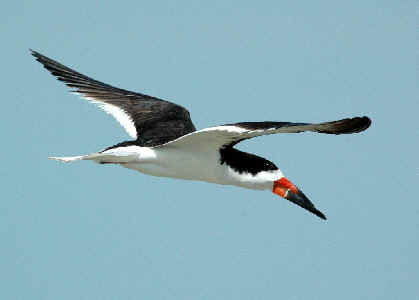
Black Skimmer
(photo by Howard Eskin)
PIGEONS & DOVES
- Common (or Feral) Pigeon (NAi)
(*) ______
e,s,c,w nm mar apr
may
Columba livia
- Band-tailed Pigeon (ph) (*) ______ w
Patagioenas
(formerly Columba) fasciata
- Red-billed Pigeon (USr)
______
Patagioenas
(formerly Columba) flavirostris
The Red-billed Pigeon is
widespread in Central America and common in northeastern Mexico. The species
barely enters the United States along the Rio Grande in South Texas. Its
presence in Texas is continually under threat due to changes in their
preferred riparian habitats.
- White-crowned
Pigeon (TXr) ______
Patagioenas (formerly Columba) leucocephala
- Eurasian Collared Dove (NAi) (*) ______ e,s,w
nm mar apr may
Streptopelia decaocto
- White-winged Dove (ph) (*) ______
e,s,c,w
nm,mx mar apr may
Zenaida asiatica
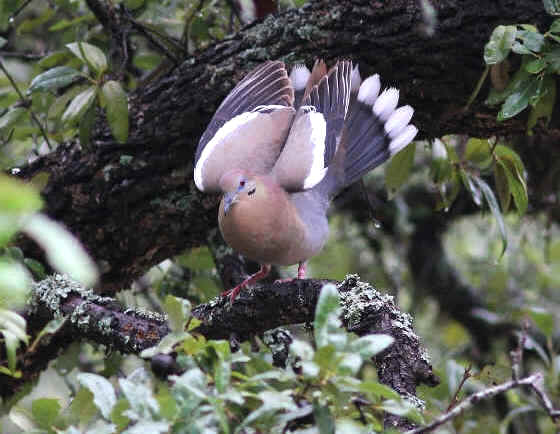
A White-winged Dove photographed in Wimberley, Texas
(photo by Rhett Poppe)
- Mourning Dove (*) ______ e,s,c,w
nm mar apr may
Zenaida macroura
- Inca Dove (ph) (*) ______ e,s,w
apr may
Columbina
(or said by some to be Scardafella) inca (monotypic)
- Common Ground Dove (ph) (*) ______ s,c
(mex) apr may
Columbina passerina pallescens
- Ruddy Ground Dove
(USr) (TXr) (ph) ______
Columbina talpacoti
The Ruddy Ground Dove has
appeared in Texas in the Lower Rio Grande Valley and in the
Trans-Pecos.
- White-tipped Dove (*) ______ s
(mex) may
Leptotila verreauxi
- Ruddy Quail Dove (USr)
(TXr) ______
Geotrygon montana
A Ruddy Quail Dove was at
the Bentsen-Rio Grande Park, in Hidalgo County, from March 2 to 6,
1996.
PARAKEETS & PARROTS
- Monk Parakeet (NAi) (*) ______
c may
Myiopsitta monachus
- Green Parakeet (NAr) (*) ______ s
(mex) may
Psittacara (formerly Aratinga) holochlora
- Red-crowned Amazon (or Parrot) (t2)
(NAr) (*) ______ s (mex) may
Amazona viridigenalis
CUCKOOS & ALLIES
- Yellow-billed Cuckoo (ph) (*) ______ e,s
apr may
Coccyzus americanus
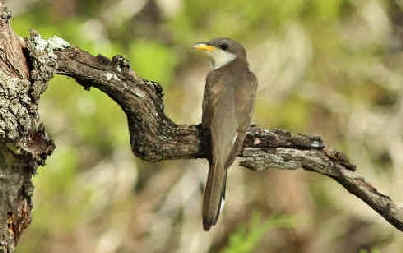
A Yellow-billed Cuckoo photographed in Wimberley, Texas
(photo by Rhett Poppe)
- Black-billed
Cuckoo ______
Coccyzus erythropthalmus
- Mangrove Cuckoo (TXr) (ph)
______
Coccycus minor
- Dark-billed Cuckoo
(USr) (TXr) ______
Coccycus melacoryphus
- Greater Roadrunner (ph) (*) ______ s,w
mar apr may
Geococcyx californianus
(monotypic)
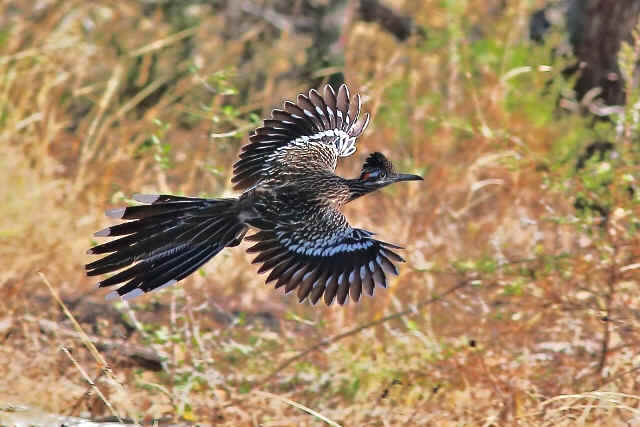
A Greater Roadrunner photographed in Wimberley, Texas
(photo by Rhett Poppe)
- Groove-billed Ani (ph) (*) ______ s
(mex) may
Crotophaga suicirostris
OWLS
- American Barn Owl (ph) (*) ______ w
apr
Tyto furcata pratincola
The American Barn Owl has been part of the Barn Owl of Eurasia
and Africa, Tyto alba.
But Tyto furcata is a heavier
bird, with a larger and stouter head and body, and with much more powerful
talons.
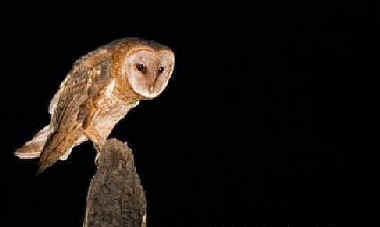
An American Barn Owl photographed during a FONT
tour
(photo by Andy Smith)
- Flammulated Owl ______
Philoscops
(formerly Otus) flammeolus
- Western Screech Owl (ph) (*) ______ w
apr
Megascops
(formerly Otus) kennicottii suttoni
- Eastern Screech Owl (ph) (*) ______ c
mar may
Megascops (formerly Otus) asio
- Great Horned Owl (ph) (*) ______
e,c,w
nm mar apr may
Bubo virginanus pallescens
- Snowy Owl (TXr) (ph)
______
Bubo scandiacus
- Northern Pygmy Owl
______
Glaucidium gnoma
- Ferruginous Pygmy
Owl (USr) (ph) ______
Glaucidium brasilianum ridgwayi ("Ridgway's Pygmy
Owl")
In Texas, the Ferruginous
Pygmy Owl is a resident of areas with oaks in the Coastal Sand Plain. It
was formerly more widespread in the Lower Rio Grande Valley, but the
conversion of native woodlands to agriculture has nearly eliminated the
species.
- Elf Owl (*) ______ w
apr
Micrathene w. whitneyi
- Burrowing Owl (ph)
______
Athene cunicularia
- Mexican Wood Owl (USr)
(TXr) ______
Ciccaba squamulata
The Mexican Wood Owl was
part of the Mottled Owl, now a South American bird.
- Barred Owl (ph) (*) _____ e
Strix varia
- Spotted Owl (ph) ______
Strix occidentalis lucida ("Mexican Spotted Owl")
- Northern Long-eared
Owl (ph) ______
Asio otus
- Stygian Owl (USr)
(TXr) ______
Asio stygius
One of the most unexpected bird
to be documented in Texas has been the Stygian Owl. With both of the
Texas records, observers were fortunate to see the birds at their day
roosts.
The second bird in Texas was at the Bentsen-Rio Grande Valley State Park,
Hidalgo County, in late December 1996.
- Short-eared Owl (ph) (*) _____ e
Asio flammens
- Northern Saw-whet
Owl (TXr) (ph) ______
Aegolius acadicus
NIGHTHAWKS &
NIGHTJARS
- Lesser Nighthawk (*) ______ e,s,c,w
nm,mx apr may
Chordeiles acutipennis
- Common Nighthawk (ph) (*) ______ e,s,c
apr may
Chordeiles minor
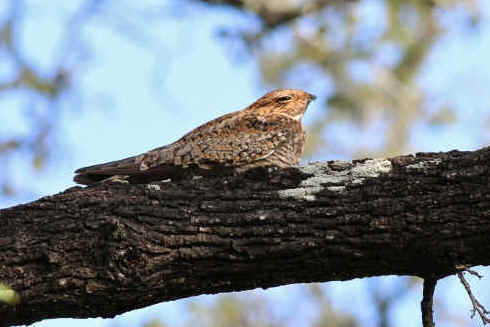
A Common Nighthawk photographed in Wimberley, Texas
(photo by Rhett Poppe)
- Pauraque (ph) (*) ______ e
apr may
Nyctidromus albicollis merrilli
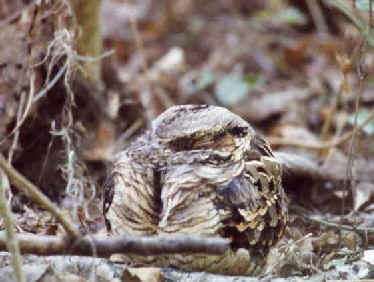
Pauraque
(photo by Marie Gardner)
- Chuck-will's-widow (*) ______ c
may
Antrostomus
(formerly Caprimulgus) carolinensis
- Eastern
Whip-poor-will ______ e
Antrostomus
(formerly Caprimulgus) vociferus
- Mexican Whip-poor-will ______ w
Antrostomus (formerly Caprimulgus) arizonae
- Common Poorwill (*) ______ w
nm apr may
Phanaenoptilus n. nuttallii
SWIFTS
- White-collared
Swift (USr) (TXr) ______
Streptprocne zonaris
- Black Swift (TXr) ______
Cypseloides niger
- Chimney Swift (*) ______ s,c
may
Chaetura pelagica
- White-throated Swift (*) ______ w
nm,mx apr may
Aeronautes saxatalis
HUMMINGBIRDS
- Green Violetear (USr)
(TXr) (ph) ______
Colibri thalassimus
- Green-breasted
Mango (USr) (TXr) (ph) ______
Anthracothorax prevostii
- Broad-billed
Hummingbird (ph) ______
Cynanthus latirostris
- White-eared
Hummingbird (USr) (TXr) (ph) ______
Hylocharis leucotis
- Berylline
Hummingbird (USr) (TXr) ______
Amazilia beryllina
- Buff-bellied Hummingbird (*) ______ s
(mex) may
Amazilia yucatanensis
- Violet-crowned
Hummingbird (USr) (TXr) (ph) ______
Amazilia violiceps
A Violet-crowned Hummingbird
was in a Texas 2010/11 Christmas Bird Count, at the Davis Mountains.
- Blue-throated Hummingbird
(or Mountain-gem) (ph) (*) _____ w (mex)
Lampornis clemenciae
- Magnificent
Hummingbird (ph) ______
Eugenes fulgens
- Lucifer Hummingbird
(or Sheartail) (ph) (*) _____ w
(mex) apr may
Calothorax lucifer
(monotypic)
- Ruby-throated Hummingbird (ph) (*) ______ e,s,c
apr may
Archilochus colubris
- Black-chinned Hummingbird (ph) (*) ______ s,c,w
nm mar apr may
Archilochus alexandri
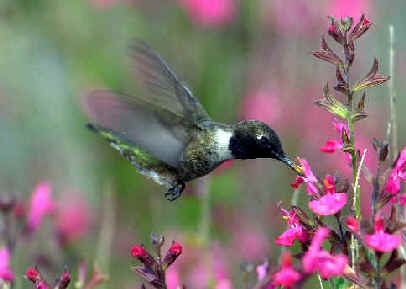
A male Black-chinned Hummingbird
(photo by Howard Eskin)
- Anna's Hummingbird (ph) ______
Calypte anna
- Costa's Hummingbird (TXr) (ph)
______
Calypte costae
- Calliope Hummingbird (ph)
______
Selasphorus
(formerly Stellula) calliope
- Broad-tailed Hummingbird (ph) (*) ______ w
nm apr may
Selasphorus platycercus
- Rufous Hummingbird
(ph) ______
Selaphorus rufus
- Allen's
Hummingbird (ph) ______
Selasphorus sasin
TROGON &
KINGFISHERS
- Elegant Trogon (TXr)
______
Trogon elegans
- Ringed Kingfisher (ph) (*) _____ s
Megaceryle
(formerly Ceryle) torquata
- Belted Kingfisher (ph) (*) ______ e,c,w
nm mar apr
Megaceryle (formerly Ceryle) alcyon
- Green Kingfisher (ph) (*) ______ s,c
(mex) may
Chloroceryle americana septentrionalis
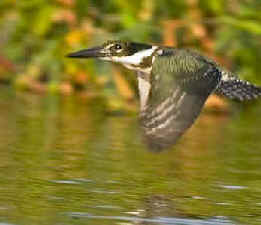
A Green Kingfisher photographed during a FONT tour
- Amazon Kingfisher (USr) (TXr)
_____
Chloroceryle amazona
The first Amazon Kingfisher
seen in the United States was in Texas in 2010. It was in Webb County that
year from Jan 24 to Feb 3.
The range of the Amazon Kingfisher is from Mexico south through much of
South America to Argentina.
WOODPECKERS
- Red-headed Woodpecker (ph) (*) _____ e
Melanerpes erythrocephalus
- Acorn Woodpecker (ph) (*) ______ w
apr may
Melanerpes f. formicivorus
- Golden-fronted Woodpecker (ph) (*) ______ e,s,c,w
mar apr may
Melanerpes a. aurifrons
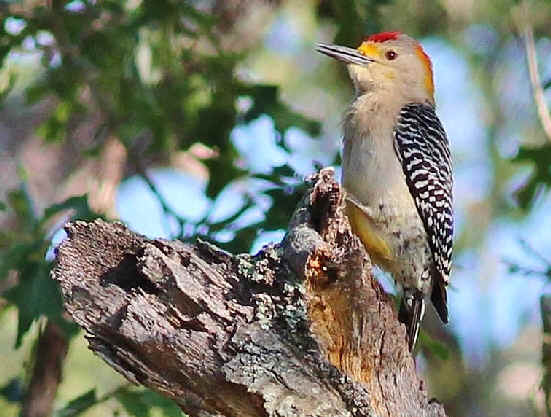
A Golden-fronted Woodpecker photographed in Wimberley, Texas
(photo by Rhett Poppe)
- Red-bellied Woodpecker (ph) (*) ______ c
mar may
Melanerpes carolinus
- Lewis' Woodpecker ______
Melanerpes lewis
- Yellow-bellied Sapsucker (ph) (*) ______
Sphyrapicus varius
- Red-naped Sapsucker (ph) (*) ______ w
apr
Sphyrapicus nuchalis
- Williamson's
Sapsucker ______
Sphyrapicus rhyroideus
- Red-breasted
Sapsucker (TXr) ______
Sphyrapicus ruber
- Ladder-backed Woodpecker (ph) (*) ______ e,s,c,w
nm mar apr may
Picoides scalaris
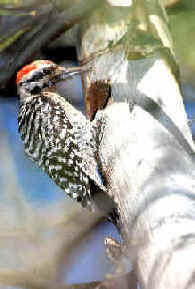
Ladder-backed Woodpecker
(photo by Howard Eskin)
- Downy Woodpecker (ph) (*) ______ c
may
Picoides pubescens
- Hairy Woodpecker
(ph) (*) ______
Picoides villosus
- Red-cockaded
Woodpecker ( ) ______
Picoides borealis
The endangered Red-cockaded
Woodpecker is a habitat specialist that requires large tracts of open
pine forest with a grassy understory.
The species seems to have continued its slow population decline even with
careful habitat management.
The place in Texas with the most is the Sam Houston National Forest in the
eastern part of the state.
- Northern Flicker ______
"Yellow-shafted" Flicker (*) ______ e
Colaptes auratus
"Red-shafted" Flicker (*) ______
w may
Colaptes auratus collaris
- Pileated Woodpecker (ph) (*) ______
e
Dryocopus pileatus
- Ivory-billed
Woodpecker ______ (species now presumed to be extinct)
Campephilus principalis
The Ivory-billed Woodpecker was
formerly a resident in the eastern part of Texas, west to the bottomlands of
the Trinity River, and along the Gulf Coast west to the Brazos River.
The three only well-documented records in
Texas were in 1885, 1900, and 1904, although there have been 45 other
published reports for the state.
TITYRA & BECARD
- Masked Tityra (USr)
(TXr) ______
Tityra semifasciata
- Rose-throated Becard (USr) (TXr) (*) ______ s
Pachyrmphus aglaiae
Rose-throated Becards
have had a history of sporadic occurrence in Texas in the Lower Rio
Grande Valley. They were more regular breeders in the 1970s. Since then,
there has not been any successful nesting of the bird in Texas, but there
have been attempts that were unsuccessful as well as instances when unmated
birds even built the distinctive nest characteristic of the
species.
A source for much of the information in this list was the
"Handbook of Texas Birds", a publication of the Texas
Ornithological Society, by Mark W. Lockwood & Brush Freeman, published
in 2004.
Subsequent information has generally been from internet
sources.
Another source of information here is the book "Rare Birds of North
America" by Steve Howell, Ian Lewington, & Will Russell, published
in 2014.
To
Top of Page.



 Birds
of TEXAS
Birds
of TEXAS 








































